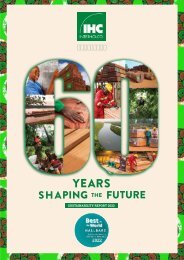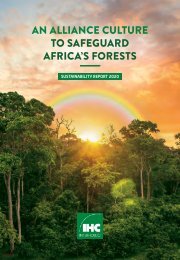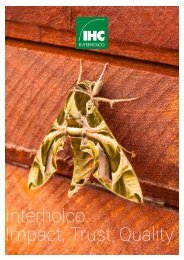Nomenclature Générale des Bois Tropicaux - 7ème édition
(english description below) Cette nomenclature est utilisée pour la mise à jour du 'Harmonized Code System' de l’Organisation Mondiale des Douanes. Dans la circulaire du 5 avril 2005, le Ministère de l’Economie, des Finances et de l’Industrie (France) reconnaît l’ATIBT comme « gardien du temple » de la nomenclature des bois tropicaux. La Commission Européenne mentionne la nomenclature de l’ATIBT comme document de référence pour la mise en œuvre du RBUE. Depuis 1954, l’ATIBT a établi et mis à jour une nomenclature des bois tropicaux faisant correspondre chaque espèce botanique avec un nom pilote reconnu internationalement. La détermination du nom pilote d’une essence est cruciale, car sa commercialisation dépend très largement de l’adoption de ce nom par le public. Le nom pilote assure la protection de l’appellation commerciale de l’essence et l’intégrité des propriétés qui lui sont attribuées, sans risque de confusion. The 1982 version of the general timber nomenclature has finally been updated as some of the 1,750 identified species, are no longer traded, while others, which were not previously included, are now on the market. The present revision has also integrated changes related to new taxonomy, in order to reflect the latest scientific developments. This Nomenclature has been used for the Harmonized Code System, updated by the World Customs Organization. The French Ministry of economy, finance and industry has given official recognition to ATIBT as the reference for the tropical timber nomenclature (NOR: PRMX0508285C of April 5th 2005). The European Commission refers to ATIBT nomenclature as a reference document for the implementation of the EUTR regulation. Since 1954, ATIBT has established and updated a nomenclature of tropical wood, linking each botanical species with an internationally recognized pilot name. A sigle wood species may have many common names; when trading across different countries, this may lead to confusion. Fixing the pilot name of a timber species is crucial, to protect the commercial denomination of the species and guarantee the veracity of the properties linked to that species, without confusion.
(english description below)
Cette nomenclature est utilisée pour la mise à jour du 'Harmonized Code System' de l’Organisation Mondiale des Douanes. Dans la circulaire du 5 avril 2005, le Ministère de l’Economie, des Finances et de l’Industrie (France) reconnaît l’ATIBT comme « gardien du temple » de la nomenclature des bois tropicaux. La Commission Européenne mentionne la nomenclature de l’ATIBT comme document de référence pour la mise en œuvre du RBUE.
Depuis 1954, l’ATIBT a établi et mis à jour une nomenclature des bois tropicaux faisant correspondre chaque espèce botanique avec un nom pilote reconnu internationalement. La détermination du nom pilote d’une essence est cruciale, car sa commercialisation dépend très largement de l’adoption de ce nom par le public. Le nom pilote assure la protection de l’appellation commerciale de l’essence et l’intégrité des propriétés qui lui sont attribuées, sans risque de confusion.
The 1982 version of the general timber nomenclature has finally been updated as some of the 1,750 identified species, are no longer traded, while others, which were not previously included, are now on the market. The present revision has also integrated changes related to new taxonomy, in order to reflect the latest scientific developments.
This Nomenclature has been used for the Harmonized Code System, updated by the World Customs Organization. The French Ministry of economy, finance and industry has given official recognition to ATIBT as the reference for the tropical timber nomenclature (NOR: PRMX0508285C of April 5th 2005). The European Commission refers to ATIBT nomenclature as a reference document for the implementation of the EUTR regulation.
Since 1954, ATIBT has established and updated a nomenclature of tropical wood, linking each botanical species with an internationally recognized pilot name. A sigle wood species may have many common names; when trading across different countries, this may lead to confusion. Fixing the pilot name of a timber species is crucial, to protect the commercial denomination of the species and guarantee the veracity of the properties linked to that species, without confusion.
You also want an ePaper? Increase the reach of your titles
YUMPU automatically turns print PDFs into web optimized ePapers that Google loves.
Liste des noms pilotes des bois tropicaux avec renvoi aux noms scientifiques /// 71
PILOT NAME BOTANICAL NAMES COMMON NAMES
Maçaranduba
Macucu de paca
Mafamuti
Mafu
Mahogany
Makamong
Manilkara bidentata A. Chev.
Manilkara huberi Ducke
Manilkara spp.
Aldina heterophylla Benth.
Newtonia buchananii Gilbert & Boutique
(Syn. Piptadenia buchananii)
Fagaropsis angolensis Gardn.
Swietenia humilis Zucc. *
Swietenia krukovii Gleason
Swietenia macrophylla King *
(Syn. Swietenia candollei)
(Syn. Swietenia tessmannii)
Swietenia mahagoni Jacq. *
Afzelia xylocarpa Craib.
Balata (CO) ; Balata (GY, VE) ; Balata franc (GF) ;
Balata gomme (GF) ; Balata rouge (GF) ; Beefwood
(GY) ; Bois Abeille (GF) ; Bolletrie (SR) ; Maçaranduba
(BR) ; Maparajuba (BR) ; Massarandu (VE) ;
Nispero (CO, PA) ; Pamashto (PE) ; Paraju (BR) ;
Quinilla colorada (PE)
Macucu da Catinga (BR) ; Macucu de paca (BR) ;
Macucu do Baixo (BR)
Lokundu (CD) ; Mafamuti (MZ) ; Mkufi (TZ) ;
Mpewere (UG) ; Umukerekwa (BI)
Mafu (TZ) ; Mfu (TZ) ; Mukarakati (KE) ; Murumu
(KE) ; Muyinga (UG) ; Rigo (CD)
Aguano (PE, BR) ; Araputanga (BR) ; Baywood
(MX) ; Caoba (BO, CO, PE, VE, CU) ; Chacalte
(GT) ; Mahogani (DO, HT, NI) ; Mahogany (DO,
HT) ; Mara (BO) ; Mogno (BR) ; Orura (VE) ; Zopilote
(MX)
Beng (KH) ; Go Do (VN) ; Go To Té (VN) ; Makamong
(TH) ; Suk (LA)
Makoré Tieghemella heckelii Pierre Abacu (GH) ; Baku (GH) ; Makoré (CI)
Malagangai Eusideroxylon malagangai Symington Malagangai (MY)
Malas
Mambodé
Mandioqueira
Mangle
Mango
Maniawga
Homalium foetidum Benth.
Homalium tomentosum Benth.
Homalium spp.
Detarium macrocarpum Harms
Detarium senegalense J.F. Gmel.
Qualea coerulea Aubl.
Qualea dinizii Ducke
Qualea paraensis Ducke
Qualea rosea Aubl.
Qualea spp.
Ruizterania albiflora Marc.-Berti
(Syn. Qualea albiflora)
Ruizterania retusa Marc.-Berti
Ruizterania spp.
Rhizophora mangle L.
Rhizophora racemosa G. Mey.
Rhizophora spp.
Mangifera foetida Lour.
Mangifera indica L.
Mangifera laurina Blume
Mangifera spp.
Carallia brachiata Merr.
(Syn. Carallia lucida)
Manil Symphonia globulifera L.
Aranga (MY) ; Banisian (MY) ; Dlingsem (ID) ; Gia
(ID) ; Kha Nang (LA) ; Khen Nang (MM) ; Melmas
(ID) ; Momala (ID) ; Myaukchaw (PH) ; Myaukugo
(PH) ; Padang (MY) ; Selimbar (MY) ; Takaliu (MY)
Aboranzork (GA) ; Amouk (CM) ; Bodo (CI) ; Boiré
(CI) ; Enouk (GA) ; Enuk (GQ) ; Kapuyai (SL) ;
Mambodé (GW)
Arenillo (BO) ; Berg Gronfoeloe (SR) ; Florecillo
(VE) ; Gonfolo (GF) ; Gronfoeloe (SR) ; Gronfolo
(SR) ; Mandioqueira (BR) ; Mandioqueira aspera
(BR) ; Mandioqueira escamosa (BR) ; Mandioqueira
lisa (BR)
Mangle asjo (CO) ; Mangle colorado (EC) ; Mangle
Paletuvier (GF) ; Mangrove (GY, SR) ; Paletuvier
rouge (GF), HT) ; Parma (SR)
Ailai (PH) ; Asai (PH) ; Asam (MY) ; Machang
(MY) ; Ma-Muang-Pa (SB, TH) ; Mangga (IN) ;
Mango (IN, (PG, PK) ; Mangowood (MM) ; Membacang
(ID) ; Pahutan (PH) ; Pamutan (TH) ; Sepam
(MY) ; Thayet (MM) ; Xoai (VN)
Corallia (MM) ; Maniawga (MM)
Anani (BR) ; Azufre (BO) ; Azufre (CO, PE) ; Brea
amarilla (BO) ; Brea caspi (PE) ; Machare (CO, EC) ;
Mangue (TT) ; Mani (BR, SR, VE) ; Manil (GF) ;
Manil marécage (GF) ; Manni (GY) ; Mataki (SR) ;
Paraman (VE) ; Peramancillo (VE) ; Puenga (EC) ;
Zaputi (EC)














